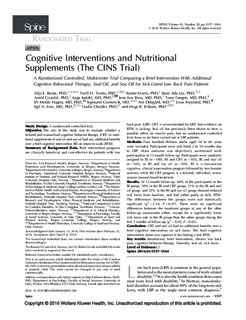| dc.contributor.author | Reme, Silje | |
| dc.contributor.author | Tveito, Torill Helene | |
| dc.contributor.author | Harris, Anette | |
| dc.contributor.author | Lie, Stein Atle | |
| dc.contributor.author | Grasdal, Astrid | |
| dc.contributor.author | Indahl, Aage | |
| dc.contributor.author | Brox, Jens Ivar | |
| dc.contributor.author | Tangen, Tone | |
| dc.contributor.author | Hagen, Eli Molde | |
| dc.contributor.author | Gismervik, Sigmund Østgård | |
| dc.contributor.author | Ødegård, Arit | |
| dc.contributor.author | Frøyland, Livar | |
| dc.contributor.author | Fors, Egil Andreas | |
| dc.contributor.author | Chalder, Trudie | |
| dc.contributor.author | Eriksen, Hege Randi | |
| dc.date.accessioned | 2018-08-01T11:05:39Z | |
| dc.date.available | 2018-08-01T11:05:39Z | |
| dc.date.created | 2016-10-28T12:27:17Z | |
| dc.date.issued | 2016 | |
| dc.identifier.citation | Spine. 2016, 41 (20), 1557-1564. | |
| dc.identifier.issn | 0362-2436 | |
| dc.identifier.uri | http://hdl.handle.net/11250/2507101 | |
| dc.description.abstract | STUDY DESIGN: A randomized controlled trial. OBJECTIVE: The aim of this study was to evaluate whether a tailored and manualized cognitive behavior therapy (CBT) or nutritional supplements of seal oil and soy oil had any additional benefits over a brief cognitive intervention (BI) on return to work (RTW). SUMMARY OF BACKGROUND DATA: Brief intervention programs are clinically beneficial and cost-effective for patients with low back pain (LBP). CBT is recommended for LBP, but evidence on RTW is lacking. Seal oil has previously been shown to have a possible effect on muscle pain, but no randomized controlled trials have so far been carried out in LBP patients. METHODS: Four hundred thirteen adults aged 18 to 60 years were included. Participants were sick-listed 2 to 10 months due to LBP. Main outcome was objectively ascertained work participation at 12-month follow-up. Participants were randomly assigned to BI (n = 100), BI and CBT (n = 103), BI and seal oil (n = 105), or BI and soy oil (n = 105). BI is a two-session cognitive, clinical examination program followed by two booster sessions, while the CBT program is a tailored, individual, seven-session manual-based treatment. RESULTS: At 12-month follow-up, 60% of the participants in the BI group, 50% in the BI and CBT group, 51% in the BI and seal oil group, and 53% in the BI and soy oil group showed reduced sick leave from baseline, and had either partly or fully RTW. The differences between the groups were not statistically significant (χ = 2.54, P = 0.47). There were no significant differences between the treatment groups at any of the other follow-up assessments either, except for a significantly lower sick leave rate in the BI group than the other groups during the first 3 months of follow-up (χ = 9.50, P = 0.02). CONCLUSION: CBT and seal oil had no additional benefits over a brief cognitive intervention on sick leave. The brief cognitive intervention alone was superior in facilitating a fast RTW. | |
| dc.description.abstract | Cognitive Interventions and Nutritional Supplements (The CINS Trial): A Randomized Controlled, Multicenter Trial Comparing a Brief Intervention with Additional Cognitive Behavioral Therapy, Seal Oil, and Soy Oil for Sick-Listed Low Back Pain Patients | |
| dc.language.iso | eng | |
| dc.title | Cognitive Interventions and Nutritional Supplements (The CINS Trial): A Randomized Controlled, Multicenter Trial Comparing a Brief Intervention with Additional Cognitive Behavioral Therapy, Seal Oil, and Soy Oil for Sick-Listed Low Back Pain Patients | |
| dc.title.alternative | Cognitive Interventions and Nutritional Supplements (The CINS Trial): A Randomized Controlled, Multicenter Trial Comparing a Brief Intervention with Additional Cognitive Behavioral Therapy, Seal Oil, and Soy Oil for Sick-Listed Low Back Pain Patients | |
| dc.type | Peer reviewed | |
| dc.type | Journal article | |
| dc.description.version | publishedVersion | |
| dc.source.pagenumber | 1557-1564 | |
| dc.source.volume | 41 | |
| dc.source.journal | Spine | |
| dc.source.issue | 20 | |
| dc.identifier.doi | 10.1097/BRS.0000000000001596 | |
| dc.identifier.cristin | 1395369 | |
| cristin.ispublished | true | |
| cristin.fulltext | original | |
| cristin.qualitycode | 2 | |
